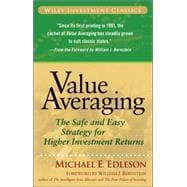
Note: Supplemental materials are not guaranteed with Rental or Used book purchases.
Purchase Benefits
What is included with this book?
|
|||
|
|||
|
|||
|
|||
|
|||
| RISK AND MARKET RETURNS. | |||
|
|||
|
|||
|
|||
| MARKET TIMING AND FORMULA STRATEGIES. | |||
|
|||
|
|||
| ENDNOTES. | |||
| 2006 NOTE. | |||
|
|||
| DOLLAR COST AVERAGING: AN EXAMPLE. | |||
| SHORT-TERM PERFORMANCE. | |||
|
|||
|
|||
| LONG-TERM PROBLEMS WITH DOLLAR COST AVERAGING. | |||
|
|||
| SUMMARY. | |||
| ENDNOTES. | |||
|
|||
| VALUE AVERAGING: AN INTRODUCTION. | |||
| SHORT-TERM PERFORMANCE. | |||
| LONG-TERM PERFORMANCE AND VALUE AVERAGING. | |||
|
|||
|
|||
| SUMMARY. | |||
| ENDNOTES. | |||
| 2006 NOTES. | |||
|
|||
| BACKGROUND. | |||
|
|||
|
|||
|
|||
|
|||
| READJUSTING THE INVESTMENT PLAN. | |||
|
|||
|
|||
|
|||
| GROWTH-ADJUSTED DOLLAR COST AVERAGING. | |||
|
|||
|
|||
|
|||
| SUMMARY. | |||
| ENDNOTES. | |||
|
|||
|
|||
| VALUE AVERAGING VALUE PATHS. | |||
|
|||
|
|||
|
|||
|
|||
|
|||
| SUMMARY. | |||
| ENDNOTES. | |||
|
|||
|
|||
| TAX CONSIDERATIONS WITH VALUE AVERAGING. | |||
|
|||
|
|||
|
|||
| REDUCING TRANSACTION COSTS. | |||
|
|||
|
|||
| SUMMARY. | |||
| ENDNOTES. | |||
|
|||
| WHY SIMULATIONS? | |||
| WHAT AND HOW? | |||
|
|||
|
|||
|
|||
|
|||
| CONSTRUCTING THE SIMULATION. | |||
|
|||
| ENDNOTES. | |||
|
|||
| 2006 NOTE. | |||
| ENDNOTES TO APPENDIX TO CHAPTER 7. | |||
| 2006 NOTE. | |||
|
|||
| FIVE-YEAR SIMULATION RESULTS. | |||
|
|||
|
|||
|
|||
| TWENTY-YEAR SIMULATION RESULTS. | |||
| SUMMARY. | |||
| ENDNOTES. | |||
|
|||
| TIRING OF A RANDOM WALK. | |||
|
|||
|
|||
| WHY DOES THIS MATTER? | |||
|
|||
| ENDNOTES. | |||
| 2006 NOTE. | |||
|
|||
| USING MUTUAL FUNDS. | |||
|
|||
|
|||
|
|||
| WORKING OUT THE DETAILS. | |||
|
|||
|
|||
|
|||
| 2006 NOTE. | |||
|
|||
|
|||
|
|||
| NOTES FOR FINANCIAL PLANNERS. | |||
|
|||
| SUMMARY. | |||
| ENDNOTES. | |||
| 2006 NOTE. | |||
|
|||
| THE GOAL AND INVESTMENT ENVIRONMENT. | |||
|
|||
|
|||
|
|||
| INVESTMENT RETURN & TAXES. | |||
|
|||
|
|||
| IMPLEMENTING DOLLAR COST AVERAGING. | |||
|
|||
|
|||
|
|||
|
|||
|
|||
|
|||
| IMPLEMENTING VALUE AVERAGING. | |||
|
|||
|
|||
|
|||
|
|||
| SUMMARY. | |||
| KEY FORMULAS. | |||
| ENDNOTES. | |||
|
|||
|
The New copy of this book will include any supplemental materials advertised. Please check the title of the book to determine if it should include any access cards, study guides, lab manuals, CDs, etc.
The Used, Rental and eBook copies of this book are not guaranteed to include any supplemental materials. Typically, only the book itself is included. This is true even if the title states it includes any access cards, study guides, lab manuals, CDs, etc.